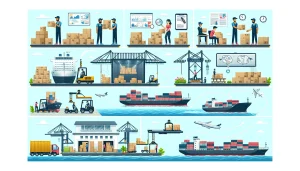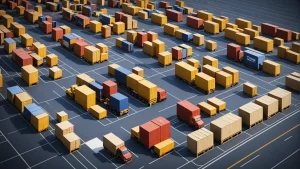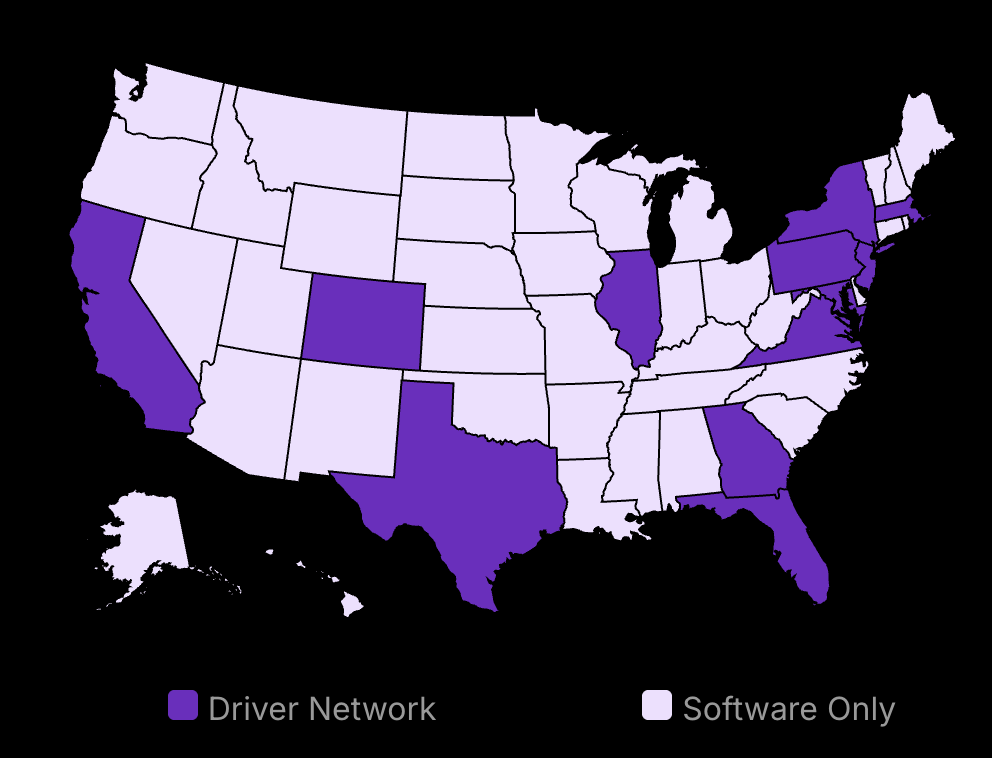A successful business’ secret isn’t a viral TikTok campaign or a celebrity endorsement. It is something far more practical: leveraging the power of wholesale distribution. Many successful small businesses owe their growth to mastering the wholesale distribution business model.
Most local business owners I talk with share the same frustration. They’ve hit what experts call the local business ceiling—the point where you’ve maxed out your immediate market, but lack the infrastructure to grow beyond it within the complex wholesale distribution industry.
Breaking that ceiling requires robust business operations and systems, perhaps including an inventory management system or a warehouse management system, that let you scale without sacrificing quality or bankrupting yourself with high operating costs. This is where wholesale distribution plays a critical role, becoming not just helpful, but transformative for managing the entire process.
Think about it: What if instead of selling one product to one customer, you could sell products in large quantities to a single buyer, like retail stores, online retailers, or even other businesses? What if your products could reach shelves in cities you’ve never visited, expanding far beyond your local reach through effective supply chain management?
Wholesale distribution isn’t just for massive wholesale distribution companies with huge distribution centers. It’s increasingly becoming the backbone for small businesses looking to expand. Wholesale suppliers, including specialized ones like food and beverage wholesalers (key players alongside specific food suppliers and beverage wholesalers in the beverage industry) or those dealing in medical supplies or sports equipment, act as crucial intermediaries between manufacturers and retailers. Businesses recognizing this shift, understanding market trends through market research, and establishing reliable relationships are pulling ahead, while others struggle with retail-only models where retailers sell directly but face scale limitations. Even sourcing raw materials can be streamlined through effective wholesale partnerships.
Projected Market Growth: The wholesale distribution sector shows significant potential, with the global market size projected to grow from $53.8 trillion in 2024 to $57.73 trillion in 2025, at a CAGR of 7.3%.
The pattern is clear: systematic wholesale distribution, underpinning supply chain stability, consistently creates the most sustainable growth path for local operations, often involving collaboration with various manufacturers.
In this guide, we’ll walk through every step of turning your local business into a wholesale powerhouse, ready to work effectively with wholesale distributors. Whether you’re contemplating selling to retail stores, online stores, or industrial customers, or already have some wholesale accounts, you’re about to discover how to make wholesale distribution your business’s greatest asset in 2025.

Lower your delivery costs by 23%
How we reduce costs:
- No delivery vehicle expenses
- Optimized local routes
- Pay-per-delivery model
- Average 23% delivery cost reduction
What is Wholesale Distribution?
Wholesale distribution involves selling products in bulk to retailers or other businesses.
It serves as an intermediary between manufacturers and retail businesses.
It helps businesses scale by expanding market reach and securing better pricing.
Examples of Wholesale Distribution
Wholesale distribution can significantly impact local businesses. Take the case of a local coffee producer who expanded beyond their local market through wholesale. By partnering with a regional distributor, this coffee business amplified its market reach to include numerous cafes and grocery chains. This led to a substantial increase in revenue. Their success story echoes in various sectors. For example, a local artisan bakery can leverage wholesale to supply bread and pastries to a broader audience, thus boosting sales and brand recognition.
Wholesale distribution goes beyond boosting revenue. Consider a family-run brewery that partnered with a wholesale distributor. This relationship allowed economies of scale in production, leading to lower unit costs. They subsequently offered competitive pricing to retailers, attracting new clients and increasing their market share. Wholesale not only enhances revenue but also strengthens a business’s market position. This model has been discussed in several journals and books, including “Distribution Revolution” by Ben Elowitz, which provides insights into transforming business through effective distribution models.
Types of Wholesale Distribution and Inventory Control Needs
Wholesale distribution can be categorized by industry and channels. Industries such as food, electronics, and fashion each have unique distribution dynamics. Food distributors might focus on freshness and speed, while electronics distributors concentrate on inventory control and technological integration. In fashion, the emphasis might be on trend movements and seasonality. For those looking to deepen their understanding, a clear and concise explanation of wholesale fundamentals is invaluable. Learning the detailed nuances of wholesale operations can empower business owners to make informed decisions that align with their growth strategies. A recommended resource is this comprehensive guide on the essential wholesale definition that every business owner should know, providing practical insights and foundational knowledge.
To further clarify the concept, it’s essential to understand that mastering the basics of wholesale distribution can significantly impact your business growth. Knowing how to navigate different wholesale models and terms can empower you to choose the right partners and strategies. For an in-depth explanation, refer to our detailed article on the wholesale distribution definition every entrepreneur should grasp. This resource breaks down the core principles and offers actionable insights tailored for small and growing businesses.
Distribution channels are another aspect. Direct distribution involves a direct line from the manufacturer to the retailer, eliminating intermediaries. This often results in higher margins for both parties. Indirect distribution includes agents or brokers who facilitate the transaction. This method broadens reach but might dilute control over pricing and brand image.
Hybrid models are also common. These models combine elements of both direct and indirect channels and might be suitable for specific products or markets. Resources such as “Distribution Channels” by Bert Rosenbloom can offer further insights into the complexities of these distribution strategies.
Direct Wholesale Distribution
In direct wholesale distribution, manufacturers sell goods directly to retailers. This model allows manufacturers to exert more control over pricing, brand positioning, and customer relationships. Retailers get the benefit of purchasing at lower prices due to the absence of middlemen, often reflecting in their pricing strategy.
Setting up a direct wholesale operation involves strategic planning. Businesses must invest in logistics, customer service, and marketing to ensure seamless deliveries and strong relationship management. Efficiency in supply chain management becomes crucial to maintain competitiveness. Case studies like Apple’s distribution strategy, where it sells directly to large retailers, provide a framework for understanding the intricacies of direct wholesale systems. Texts like “Logistics and Supply Chain Management” by Martin Christopher dive deep into such strategic implementations.
Indirect Wholesale Distribution
Indirect wholesale distribution enlists intermediaries like agents, brokers, or wholesale distributors. This approach benefits businesses unable to manage logistics and sales infrastructure independently. The use of intermediaries reduces operational costs by offloading logistics and sales responsibilities, achieving a wider market reach.
Businesses choosing this path prioritize relationship management. They focus on selecting reliable intermediaries who align with their brand ethos. The challenge lies in maintaining brand consistency and pricing across broader markets. Books like “Supply Chain Management: Strategy, Planning, and Operation” by Sunil Chopra and Peter Meindl help understand managing these dynamic relationships.
Scaling and Valuation of a Wholesale Business
Scaling a wholesale business demands strategic management across operations, relationships, and market positioning. Investing in technology to streamline operations, like advanced inventory systems, enhances scalability by ensuring consistent product availability. Building relationships with manufacturers and retailers ensures steady demand.
Recent US Market Growth: The wholesale trade market size in the U.S. has grown at a 2.0% CAGR between 2019 and 2024.
Valuing a wholesale business involves examining assets, cash flow, and market position. Typically, a business’s profitability and growth potential are central. The profit margin is influenced by the type of goods, intermediary costs, and market dynamics.
US Wholesale Revenue Growth: The U.S. wholesale trade industry revenue has grown at a CAGR of 5.6% over the past five years, reaching an estimated $17.5 trillion in 2025.
Scaling reselling businesses follows similar principles. Profits are driven by strategic sourcing and effective supply chain management, ensuring value addition and customer satisfaction. Regulatory guidance, books like “Selling to the C-Suite” by Nicholas Read, and industry reports can provide further strategies for thriving in wholesale and reselling markets.
Benefits of Wholesale Distribution for Local Businesses
Reach more people and markets beyond your local area.
Save money by buying in bulk, making your prices more competitive.
Access to Larger Markets
Wholesale distribution broadens your business reach. Local businesses can cross geographical boundaries, entering regional and national markets more easily. Wholesalers have established networks, allowing products rapid access to shelves across different zones. Traditional selling methods generally restrict businesses to limited areas due to high costs, while wholesale distribution breaks this barrier.
Consider a local cheese maker. By collaborating with a wholesaler, their products could appear not just in local stores, but in stores nationwide. This approach increases visibility and opens doors for bulk orders from larger chains. Expanding reach this way is like getting your foot in the door of markets you thought were out of reach. Businesses around the world have exploited this model to scale their operations successfully.
Wholesale distribution is one backbone of business growth. Its beneficial advantages include simplification of operations, expansion of the market, and improved customer satisfaction.
However, going beyond local markets involves challenges. Adapting products and marketing to fit different regional tastes and regulatory standards can be daunting. Yet, overcoming these challenges often leads to significant growth.
Cost Efficiency and Reducing Operating Costs
Wholesale distribution cuts costs. Buying in bulk brings economies of scale, which makes your per-unit cost lower. This benefits local businesses, particularly smaller ones, in a significant way. For instance, if you own a small clothing brand, wholesale could enable you to reduce operational and production costs, allowing for competitive pricing. Passing these savings onto customers also enhances your pricing strategy.
Consumer Savings Behavior: Approximately 75% of consumers are purchasing some product categories in bulk to save money.
“One of the most powerful facilitators for wholesale distribution is its capability to expand the market reach of a business.” This happens partly by sharing the cost benefits with clients. Wholesalers can negotiate better prices due to their higher purchasing volume, an opportunity retail stores cannot always leverage on their own.
However, not all is rosy with cost efficiency. Holding large inventories might strain finances if managed poorly. Ensuring a constant supply chain to match bulk buying can present a challenge. Nonetheless, implementing effective management systems and demand forecasting reduces risks. Supply chain experts like Joseph Hellers suggest aligning with strategic partners and embracing technology to stabilize inventory levels.
These opportunities underscore how pivotal wholesale distribution can be in accelerating growth and enhancing operational efficiency. Addressing the balance of opportunities and challenges prepares businesses to reap sustainable benefits.
How does Wholesale Distribution Work within Business Operations?
Streamlines product flow from manufacturers to retailers, enhancing business reach.
Involves complex logistics and supply chain coordination.
Aids in broadening market presence for local businesses.
Overview of the Wholesale Distribution Process: Handling Large Quantities
Wholesale distribution is about moving products efficiently from manufacturers to retailers. This process usually involves buying large quantities of goods from producers and then selling them in smaller quantities to businesses. Wholesalers bridge the gap between production and retail, ensuring products get to where they’re needed. They handle crucial tasks such as storage, inventory management, and even transportation.
Typically, a wholesaler operates by negotiating with manufacturers to get the best prices, which allows them to offer competitive rates to retailers. This system not only benefits manufacturers by alleviating the logistics burden but also allows retailers to access a wide range of products without investing in significant stock.
Real-world examples show the benefits, like how electronics wholesalers ensure rapid product turnover, enabling retailers to stay updated with the latest tech. Wholesalers in the fashion industry often operate similarly, ensuring clothing lines reach stores quickly. These systems help stabilize pricing and availability across markets, benefiting all parties involved.
Explanation of the Supply Chain from Manufacturer to Retailer
The supply chain in wholesale distribution involves several key players. It starts with the manufacturer creating the product. Then, a wholesaler buys the product and handles its distribution to retailers. This process can vary in complexity depending on the type of product and market needs.
At the base level, manufacturers produce goods. They focus on making quality products without worrying about selling them directly to consumers. Here, wholesalers come in, purchasing products in bulk. They bear the risks of storage, transportation, and demand forecasting. Once products are adequately stored, wholesalers ship them to retailers in quantities that suit their needs. Retailers then sell these products to end consumers, completing the supply chain loop.
There’s a growing trend for wholesalers to incorporate digital solutions in logistics. This trend aligns with a shift toward real-time inventory data, offering better service to retailers while minimizing excess stock. The rise of e-commerce platforms has further blurred the lines, with some wholesalers connecting directly with consumers.
Strategies for Effective Wholesale Distribution
Build strong partnerships to drive success.
Manage inventory efficiently with technology.
Automate and prioritize customer needs for smooth operations.
Step 1: Building Strong Relationships through Customer Relationship Management
Fostering strong relationships in wholesale distribution is crucial for sustained success. Manufacturers and retailers are not just business partners; they are integral to the distribution network. Building relationships involves much more than basic communication. It is about developing trust, mutual respect, and understanding shared goals and challenges. A stable relationship can ease negotiations, align pricing strategies, and improve collaboration. Consistent and open communication is the backbone of these partnerships. It’s vital to maintain regular contact through meetings, emails, or calls, and to discuss both successes and areas of improvement. A transparent approach helps to quickly address any issues and paves the way for finding resolutions together.
Part of the relationship-building process includes active listening. Listening to partners’ needs, preferences, and feedback creates a foundation for a long-lasting relationship. Taking their concerns into account when making decisions ensures that you are both on the same page, reducing friction. To enhance communication skills and partnership building, consider books like “Compelling People: The Hidden Qualities That Make Us Influential” by John Neffinger and Matthew Kohut. This book provides insight into influence and communication skills that can enhance business relationships. Conversely, not investing time and effort in building these relationships can lead to misunderstandings, missed opportunities, and ultimately, loss of business.
Step 2: Efficient Inventory Management using an Inventory Management System
Inventory management in wholesale distribution is vital to meeting demand without excess. Maintaining the right stock levels is not only about having enough products but about stocking the right products. Proper inventory management reduces storage costs and minimizes waste, leading to increased profitability. Utilizing technology can transform inventory management. Software tools allow for real-time tracking and analysis of stock levels, helping anticipate demands and adjust orders accordingly.
The digital transformation of inventory processes ensures streamlined operations. Automated systems can set reorder points, generate real-time alerts, and produce detailed analytics. This technology-driven approach reduces the likelihood of human error and allows for data-driven decisions. For further reading on digital inventory solutions, “The Lean Supply Chain: Managing the Challenge at Tesco” by Barry Evans and Reichhart can provide in-depth insight into efficient supply chain strategies.
Despite the benefits of technology, it’s essential to weigh it against traditional methods. While tech solutions enhance accuracy, they require investment and training. It’s critical for businesses to assess the cost-benefit of such investments carefully. A balanced integration of technology with traditional practices can optimize inventory management without overwhelming the operation.
3 Tips for Optimizing Wholesale Distribution and Order Fulfillment
Software for Order Management and Tracking: Using specialized software can simplify the entire order process. It can automate tasks from order creation to fulfillment, ensuring efficiency through each phase. By opting for integrated systems, businesses can manage various channels seamlessly, ensuring all data is synchronized.
Automation to Streamline Operations: Automation reduces errors and speeds up operations. Employing automation tools in order processing, shipment tracking, and even customer service can deliver faster service to clients, enhancing satisfaction. However, the initial setup requires significant planning and strategy. Books such as “Automate This: How Algorithms Came to Rule Our World” by Christopher Steiner can deepen understanding of automation impacts.
Prioritize Client Satisfaction: Reliable service should always be the priority. Providing accurate information and delivering on promises builds trust. Developing a robust system for quick responses and efficient resolution of issues is crucial. Tony Hsieh’s quote, “Customer experience needs to be the backbone of your entire business model,” highlights the importance of customer focus in every strategy.
These pointers emphasize crucial aspects of distribution and serve as a framework for optimizing operations. While implementing these strategies, keep in mind the scale and specific needs of the business. Each business is unique, and strategies should be adapted accordingly for maximum efficiency and impact.
Overcoming Challenges in Wholesale Distribution
Local businesses often face supply chain and competition challenges in wholesale.
Flexible contracts and unique selling points can turn challenges into opportunities.
Small businesses can compete with larger distributors by leveraging their strengths.
Adaptation to Market Fluctuations
Handling market fluctuations is crucial in wholesale distribution. These changes can emerge due to various factors like economic shifts, consumer preferences, or geopolitical events. A primary concern is supply chain disruptions. A report from The World Economic Forum emphasizes that supply chain bottlenecks can lead to increased costs and unsatisfied customers. Businesses should prioritize robust supply chain management to mitigate these risks. An effective way is to have multiple suppliers. This reduces dependency on a single source, increasing resilience.
Flexible contracts and supply agreements are vital. They allow businesses to quickly adapt to changes in supply or demand. Harvard Business School’s article Negotiating Flexible Agreements highlights how adaptable contracts can be a strategic asset. These contracts can include clauses for volume adjustments or price changes based on market conditions. Keeping a buffer stock or safety inventory can be tactical against unexpected supply chain disruptions. However, it involves capital that some small businesses might not have. It’s a balance. Resources like Logistics and Supply Chain Management by Martin Christopher are useful for deeper understanding.
Competition with Larger Distributors: Offering Value-Added Services
Competing with larger distributors involves turning disadvantages into strengths. Larger distributors benefit from economies of scale, often leading to lower prices and wider reach. However, small businesses have unique selling points (USPs). These can be quality, personalized service, or niche market expertise. Lean on this.
Leveraging USPs effectively requires targeting the right audience. Small distributors can focus on niche markets overlooked by larger players. Blue Ocean Strategy by Chan Kim and Renée Mauborgne explores creating uncontested market space. Another tactic is fostering close relationships with clients. Personalized service can be a differentiation that bigger, more impersonal distributors cannot match.
Many small businesses undervalue their brand story. Sharing this with potential clients can create a connection and establish trust. Furthermore, local presence can be an advantage. Highlighting reduced transit times or supporting local economies resonates with consumers. Utilize platforms like LinkedIn to engage with target audiences and highlight these strengths. Publications like Positioning: The Battle for Your Mind by Al Ries and Jack Trout offer insight into branding strategies.
Enhancing Technological Integration
Technology is a boon for small businesses aiming to overcome wholesale challenges. Advanced software can streamline operations and improve efficiencies. Enterprise Resource Planning (ERP) systems are essential for managing operations efficiently. These provide integration of core business processes in real-time. When small distributors employ technology, they access detailed analytics that drive informed decision-making.
Consider Software-as-a-Service (SaaS) solutions. These offer cost-effective access to sophisticated resources without heavy infrastructure investments. With SaaS, even small players can compete in customer service quality against larger competitors. Automation tools can reduce manual errors. Implementing technology should not be random. Focus on tools matching business goals and size. The Lean Startup by Eric Ries is a guiding resource for implementing technology pragmatically.
Building Strong Partnerships with Business Partners
Robust partnerships are non-negotiable in wholesale. They support scaling by providing stability and consistent growth. Establishing trust is the foundation of these relationships. Communication aligns goals, expectations, and practices. Negotiation insights from books like Getting to Yes by Roger Fisher can aid in securing beneficial agreements.
Networking fuels partnerships. Attending industry events can lead to valuable connections that foster growth. Trade shows, industry associations, and online professional groups are great places to start. Leveraging these platforms provides exposure to new opportunities and insights into best practices.
It’s beneficial to nurture current partnerships as well. Regular assessments or feedback loops can ensure the relationship remains mutually beneficial. Periodic reviews bring adaptability, allowing businesses to pivot and stay ahead in a dynamic market environment.
Navigating Regulatory Challenges
Navigating regulations is intricate. Compliance with local and international regulations is non-negotiable. It mitigates risks such as fines or disruptions. Businesses should allocate resources to stay informed about changes in trade policies. This applies particularly if they cross borders. Regulations such as the General Data Protection Regulation (GDPR) impact data handling practices. Familiarizing with these keeps operations smooth.
Consider leveraging consultancy firms for guidance. They’re equipped to handle complexities, leaving businesses to focus on core activities. Books like Regulation: A Primer by Michael Levi are excellent resources for understanding regulatory frameworks.
Future Trends in Wholesale Distribution 2025
Sustainability is reshaping operations and consumer expectations.
Tech advancements enable precision and efficiency in inventory and order management.
Smart data use and AI to become essential for staying competitive.
Emphasis on Sustainability
In 2025, sustainability is not just a trend but a necessity. B2B customers expect companies to prioritize sustainability. This sparks considerable changes across operations.
Investment in renewable energy is a crucial focal point. Distributors are exploring wind and solar energy, aligning with consumer demands for eco-friendly products. This shift is more than just a green initiative; it’s becoming a profit center. Renewable energy products attract consumers looking for lower-carbon options. This means wholesale distributors not only need to stock sustainable products but also to innovate in delivering them.
Consumer Sustainability Preference: Consumers are willing to spend an average of 9.7% more on sustainably produced or sourced goods, even amid cost-of-living and inflationary concerns.
Sustainable logistics efforts are rising. Efficient route planning and cleaner fuel alternatives reduce carbon footprints and save costs. Companies like HBMS argue that this approach answers consumer demand and enhances profitability. To delve deeper into the integration of sustainable practices, “The Future of Supply Chain and Logistics” by John Gattorna offers a thorough perspective on sustainable supply chain strategies.
High-Tech Technological Advancements
Tech is driving wholesale distribution forward. These technologies refine demand forecasting, improving operational efficiency.
AI enhances personalization. Systems can offer tailor-made product recommendations and marketing campaigns. The insights AI provides are transformative. Simon Ellis from IDC underscores the necessity for adaptation, asserting that leading the charge in tech adoption positions businesses for success. To further explore AI’s potential, “Artificial Intelligence for Business” by Doug Rose is a resourceful guide that broadens understanding of AI in real-world applications.
For better decision-making, data analytics is indispensable. Utilizing vast datasets optimizes inventory levels, minimizing waste and maximizing availability. As businesses lean on predictive analytics to foresee trends and demands, WizCommerce highlights the importance of anticipating customer needs to streamline product availability. For a comprehensive analysis of AI-driven analytics, “Data Analytics for Business: Unlocking the Power” by Foster Provost provides deep insights and case studies.
Digital Transformation
Wholesale distribution relies increasingly on digital transformation. Online marketplaces and e-commerce platforms connect distributors with a global audience. As retailers increasingly turn online, the landscape shifts to support digital sales strategies more than ever before.
Mobile technology has emerged as a keystone. From tracking shipments to managing inventory, mobile solutions streamline complex operations. The adoption of mobile platforms means addressing critical logistics needs faster and more accurately. It’s a shift from manual to mobile-first. For insights into mobile solutions in logistics, “Mobile Commerce and Emerging Technologies” by Ali Farhoomand offers detailed observations.
Blockchain technology, while complex, holds potential for wholesalers. It offers enhanced transparency and trust in supply chains. By reducing fraud and boosting traceability, blockchain instills confidence in businesses and customers alike. Blockchain’s current exploration in the sector showcases how tangible benefits outweigh theoretical promises. To further investigate blockchain’s impact on distribution, “Blockchain Basics” by Daniel Drescher provides a foundational understanding.
Supply Chain Optimization
AI empowers refined supply chain optimization. Processing extensive datasets fine-tunes demand forecasting, handling more variables with precision. This makes it easier to manage supply chains efficiently. AI’s role in processing data allows for more reactive and proactive supply chain management.
Exploring blockchain technology for transparency highlights its influence. Reducing fraud and enhancing traceability benefits not just the distributors but the whole supply chain network. Harvard’s business review suggests that blockchain is crucial to modern supply chains. It’s a tool to ensure integrity without extensive bureaucratic overhead.
For more on supply chain innovations, “The Agile Supply Chain” by Remko van Hoek explores forward-thinking practices. It uncovers how technology changes logistics landscapes decisively, preparing businesses for rapid market shifts and customer expectations.
Customer-Centric Approach
The wholesale distribution landscape is adopting a customer-centric focus. With personalization taking center stage, tailored experiences are forming lasting bonds. Distributors cater to individual needs, using AI to offer personalized product recommendations and targeted marketing campaigns.
Understanding customers involves digging deep into data. It’s about predicting and fulfilling exact wants and offering unmatched service quality. AI’s role in this arena is pivotal. It’s a matchmaker for products and consumers. As HBMS emphasizes, balancing customization with scale often challenges but also rewards businesses.
To investigate deeper into personalization strategies, “Customer Centricity” by Peter Fader offers an analyzed compass for navigating business-consumer relationships, ideal for practitioners seeking enhanced customer engagement.
Conclusion
As we look ahead to 2025, wholesale distribution stands as a key growth driver for local businesses seeking to expand. The wholesale distribution industry thrives on connecting manufacturers and retailers, allowing your business to reach wider markets often at attractive prices, helping manage operating costs. The strategies we’ve covered—building reliable relationships (perhaps managed via customer relationship management or CRM software), effective supply chain management including precise inventory tracking via an inventory management system, and using advanced technologies to streamline business operations and warehouse operations—provide a clear roadmap for success within the wholesale distribution sector.
Remember that challenges like shifting market trends and competition with larger wholesale distributors or established food suppliers and beverage wholesalers (especially in the competitive beverage industry) can be overcome. Flexibility, focusing on value-added services, providing superior service through excellent customer interactions, and analyzing sales performance data are key. Most distributors recognize that the future favors businesses embracing sustainability and data-driven decisions.
Whether you choose direct distribution or work through intermediaries like wholesale suppliers or specific wholesale distribution companies, the goal remains the same: scale your local business profitably and sustainably across the supply chain. Wholesalers tend to buy in large quantities, which can significantly boost your volume. Focus on strategies that reduce carrying costs associated with maintaining inventory. Start small, implement one strategy—perhaps optimizing warehouse operations or improving order processing—measure your results, and adjust. Don’t forget key functions like human resources play a role in scaling effectively.
Ultimately, wholesale distribution is more than just efficient order fulfillment and managing shipping costs. It’s about creating connections—with various manufacturers, retailers, online retailers, and ultimately impacting your own customers (even if indirectly)—that help your local business thrive. Leveraging high tech solutions throughout the entire process can provide a competitive edge in this connected marketplace. The opportunity to scale is yours for the taking. Finding the right suppliers is critical in this journey. To help you get started, check out our guide on Best Vendors for Small Businesses to source products effectively. Building strong vendor relationships will complement your wholesale distribution strategy and ensure consistent product quality and availability.
Choosing the right vendors is a crucial step for small businesses aiming to expand through wholesale distribution. A well-selected vendor can provide not only competitive pricing but also reliability, quality, and support services that align with your business goals. To make the best choices, consider factors like vendor reputation, product range, delivery capabilities, and customer service responsiveness. For a comprehensive resource on this topic, explore our detailed post about top vendors for small businesses which offers insights and tips to identify the best partners to drive your wholesale growth strategy.



























